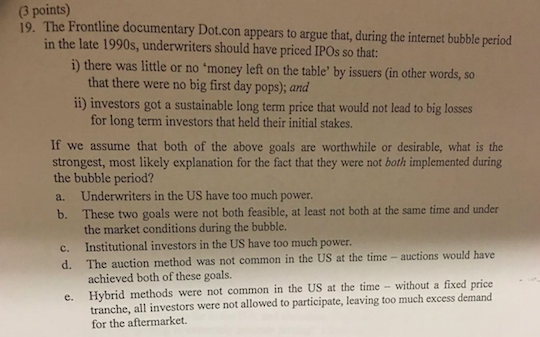
The Frontline documentary Dot can appears to argue that, during the internet bubble period in the late 1990s, underwriters should have priced IPOs so that: i) there was little or no 'money left on the table' by issuers (in other words, so that there were no big first day props); and ii) investors got a sustainable long term price that would not lead to big losses for long term investors that held their initial stakes. If we assume that both of the above goals are worthwhile or desirable, what is the strongest, most likely explanation for the fact that they were not both implemented during the bubble period? a. Underwriters in the US have too much power. b. These two goals were not both feasible, at least not both at the same time and under the market conditions during the bubble. c. Institutional investors in the US have too much power. d. The auction method was not common in the US at the time - auctions would have achieved both of these goals. e. Hybrid methods were not common in the US at the time - without a fixed price tranche, all investors were not allowed to participate, leaving too much excess demand for the aftermarket. The Frontline documentary Dot can appears to argue that, during the internet bubble period in the late 1990s, underwriters should have priced IPOs so that: i) there was little or no 'money left on the table' by issuers (in other words, so that there were no big first day props); and ii) investors got a sustainable long term price that would not lead to big losses for long term investors that held their initial stakes. If we assume that both of the above goals are worthwhile or desirable, what is the strongest, most likely explanation for the fact that they were not both implemented during the bubble period? a. Underwriters in the US have too much power. b. These two goals were not both feasible, at least not both at the same time and under the market conditions during the bubble. c. Institutional investors in the US have too much power. d. The auction method was not common in the US at the time - auctions would have achieved both of these goals. e. Hybrid methods were not common in the US at the time - without a fixed price tranche, all investors were not allowed to participate, leaving too much excess demand for the aftermarket







